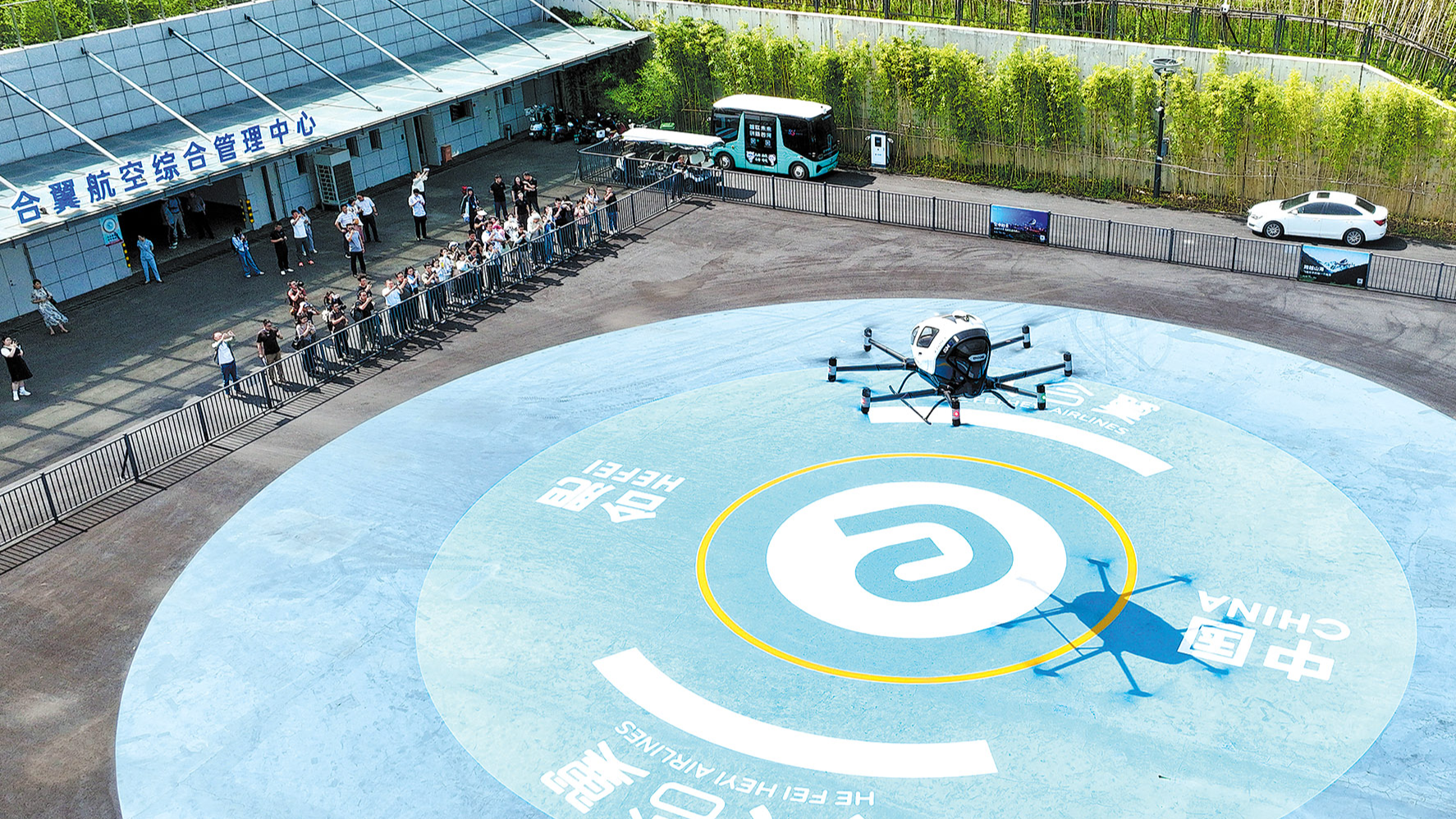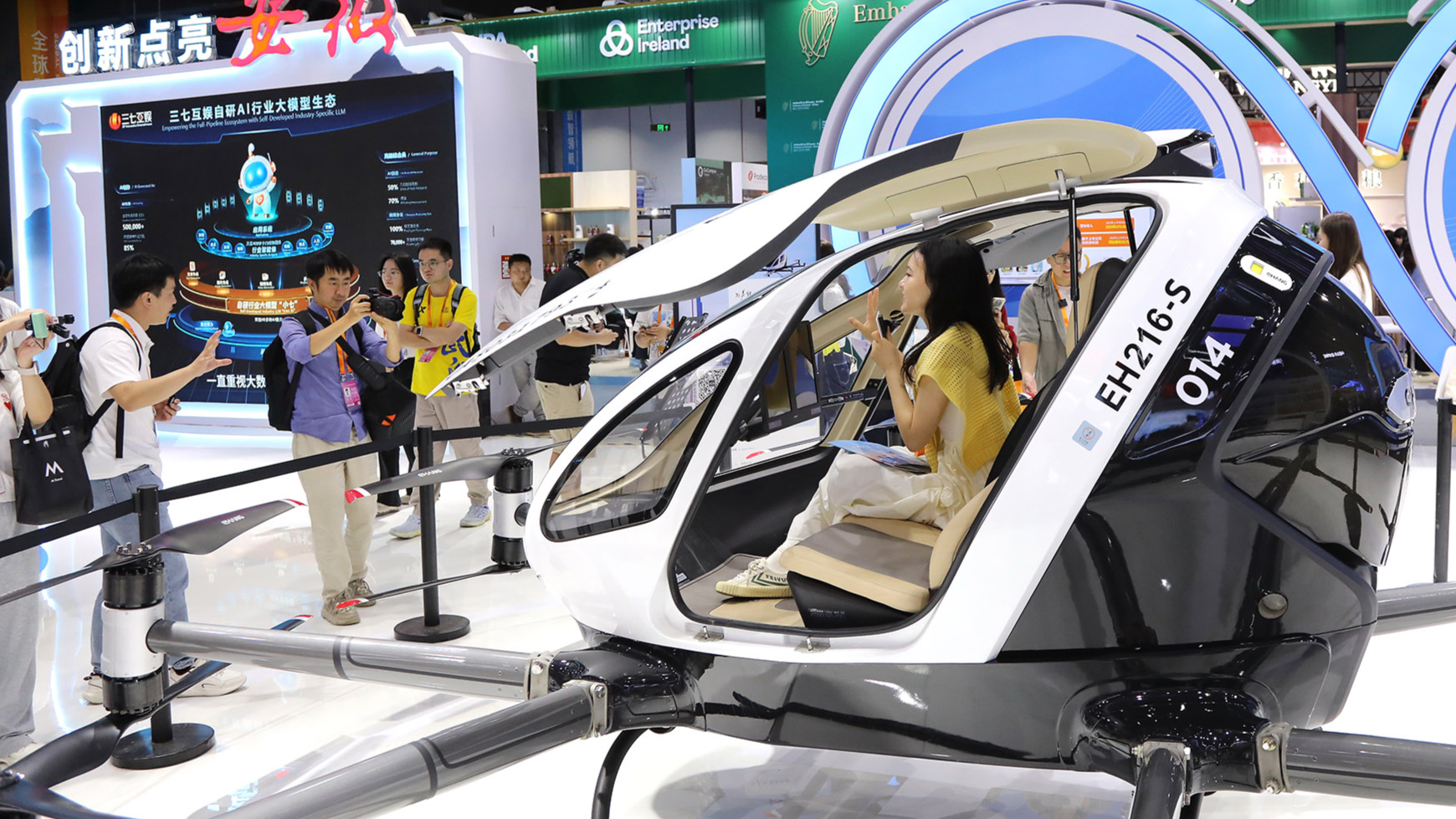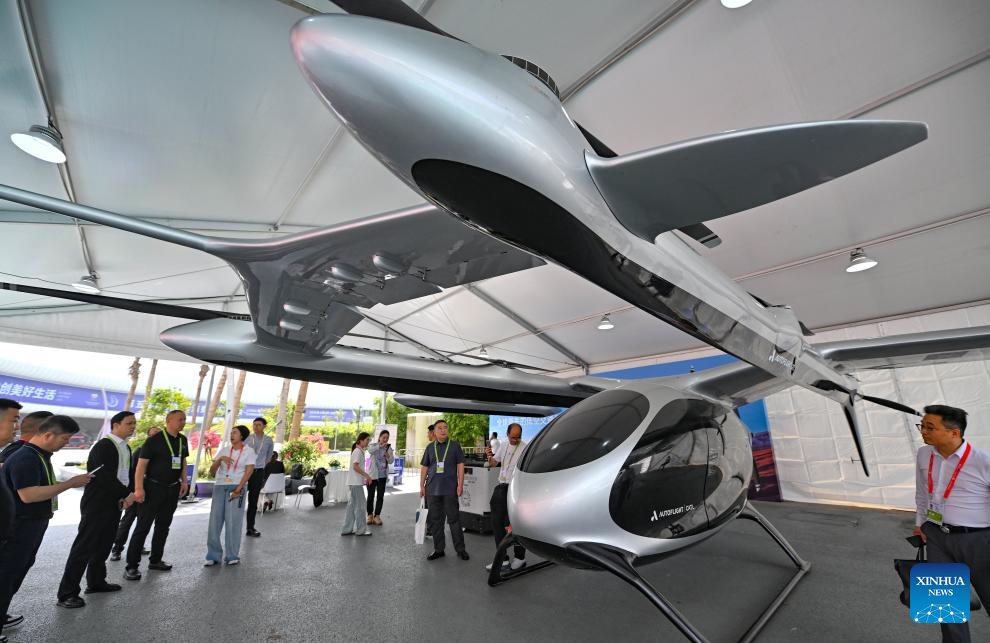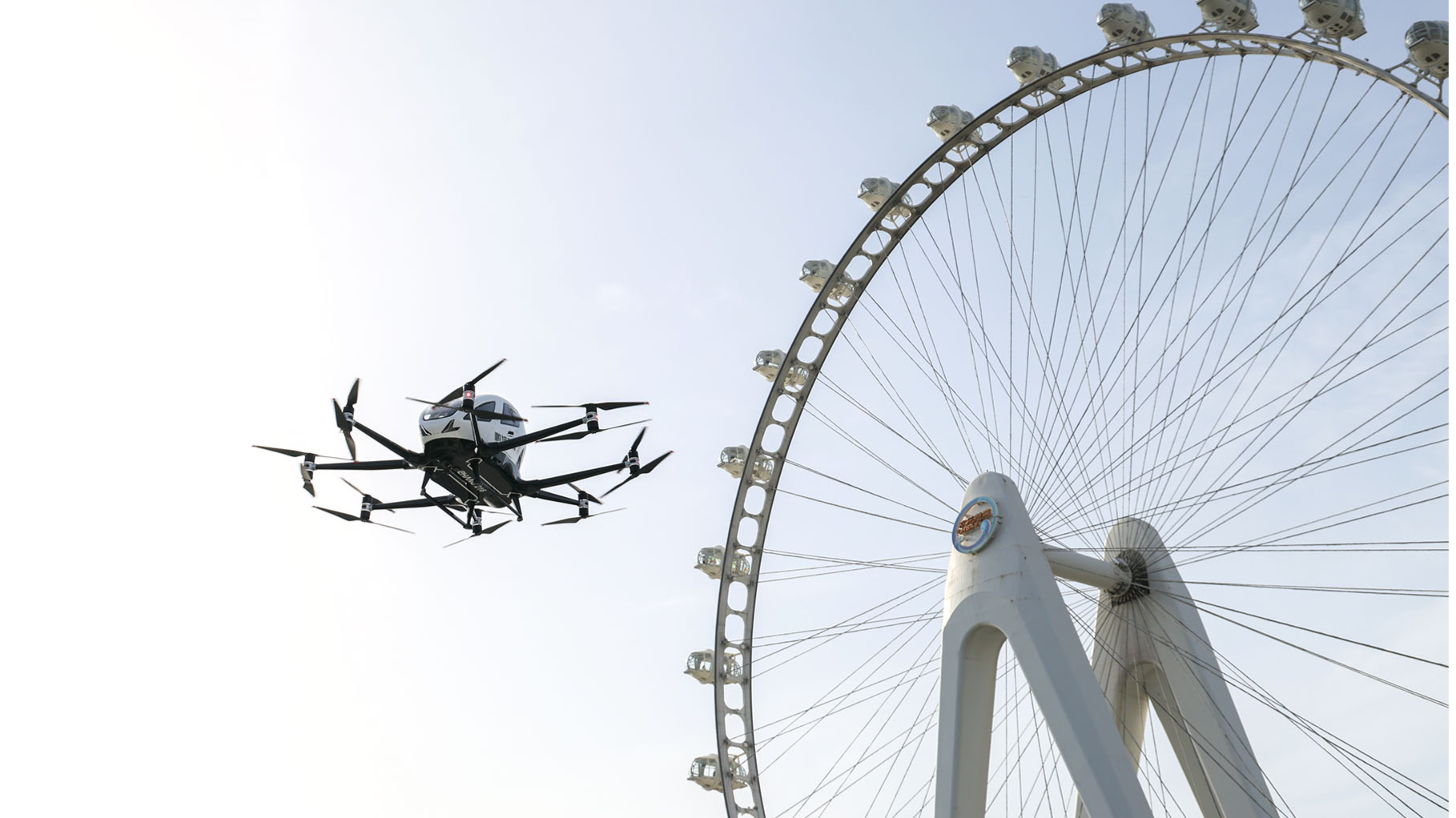
TIANJIN - The seventh China Helicopter Exposition, which concluded on Sunday in North China's Tianjin municipality, featured a 5,000-square-meter pavilion dedicated to the low-altitude economy, attracting crowds with a striking orca-shaped eVTOL, an electric vertical take-off and landing aircraft developed in China.
The all-electric aircraft, with a maximum take-off weight of 3,180 kg and a range of up to 300 km, is designed for medical rescue missions and also supports urban air mobility and cargo transportation.
As the only national-level international helicopter exhibition in China and the world's second-largest helicopter event, the four-day expo attracted over 400 enterprises from more than 20 countries and regions, setting a record in the event's history.
ALSO READ: Country's low-altitude economy aims sky high
It showcased cutting-edge technologies, innovative products, and latest achievements in the global helicopter, unmanned aerial vehicle (UAV) and general aviation sectors, highlighting the boundless potential of the low-altitude economy.
"This event provides a key platform for us to engage with our customers and partners, and to gain critical market insights," said Colin James, managing director of Airbus Helicopters in China. Over the past three years, the company has expanded its footprint by establishing a new headquarters in Hengqin, South China's Guangdong province, and collaborating with partners in the provinces of Guangdong and Shandong to develop their local support infrastructure.

The low-altitude economy, as a national strategic emerging industry, bridges advanced manufacturing with new business forms such as the digital economy, new consumption models and smart cities. It is emerging as a core engine for developing new quality productive forces and fostering new economic growth drivers for China.
Huge market opportunities
In the China-Singapore Tianjin Eco-City, located around 30 km from the exhibition venue, a request for inspection from local departments, such as environmental protection or emergency services, triggers a well-orchestrated process within Tianjin's intelligent public management platform, ensuring efficient and coordinated responses. From one of the many lotus pod-shaped automated drone airports across the city, a drone no larger than a water cup takes off. It autonomously plans its flight route and carries out the inspection mission.
"In this fully autonomous drone inspection system, the drones are equipped with AI chips, enabling operations without human intervention and effectively addressing long-standing challenges associated with traditional inspection methods," said Zhu Shengli, co-founder of i-KINGTEC, a low-altitude infrastructure solutions provider at the expo.
According to Zhu, the system has been deployed in over 30 provinces and municipalities across China. It provides an integrated "drone-network-cloud" solution for sectors including local power utilities, new energy, firefighting and emergency response, urban governance, forestry and smart tourism.
ALSO READ: eVTOL sector hits new highs
The emergence of companies like i-KINGTEC is part of a broader national surge in the low-altitude economy. The sector has gained unprecedented impetus after being included in the government work report in 2024, which positioned it as a new growth engine alongside biomanufacturing and the commercial space sector.
For more than a year, about 30 provincial-level regions across the country have incorporated the development of the low-altitude economy into their government work reports or introduced relevant policies to accelerate the implementation of low-altitude economy projects.
Zhu believes that these policies have generated strong momentum for enterprises to achieve greater development. His company was incubated in 2017 in Beijing's Zhongguancun, known as China's Silicon Valley, and relocated its core departments to Tianjin just one year later. Now, the company has filed over 600 intellectual property applications and expanded its team from just over 10 members to more than 500 employees.

China's low-altitude economy is projected to hit a market size of 1.5 trillion yuan (about $211.42 billion) by 2025 and advance further to 3.5 trillion yuan by 2035, as forecast by the Civil Aviation Administration of China.
Data from Qichacha, a leading platform offering company information inquiry services, shows that there are currently 89,000 active enterprises related to the low-altitude economy in China. Among them, approximately 11,700 were registered in the first five months of this year, a surge of 220 percent year on year, surpassing the total number of registrations for the entire previous year.
"We really appreciate how fast the market is developing in China, how many manufacturers are appearing, and how fast the technologies are moving into real practice -- not just research and development, but into actual operations and real flights," said Kirill Burenkov, representative of Russian Helicopters, in an interview with Xinhua.
"We have achieved growth in the Chinese market for three consecutive years and hold equally high expectations for the coming year," James said.
Accelerating global expansion
Recently, the night sky above an international conference center in Bamako, capital of the Republic of Mali in West Africa, lit up as 1,000 drones slowly ascended, moving in time with the music and forming a variety of patterns reflecting local culture.
This dazzling aerial display was presented by EFY Intelligent Control (Tianjin) Technology Co, Ltd (EFYI), a Tianjin-based leader of intelligent industrial drones and system solutions. This year, its fleet of nearly 10,000 drones has expanded to over 20 countries and regions worldwide.
Notably, the global expansion of China's low-altitude sector has shifted from simple product exports to delivering a comprehensive package of its technology, standards, infrastructure and business models.
READ MORE: Low-altitude economy attracts more aero firms
EFYI, for instance, now operates in over 40 countries and regions across a range of fields, from drone performances to smart logistics and inspection security, its founder Qi Juntong said.
Phoenix Wings (Shenzhen) Co, Ltd is systematically enhancing its service capabilities and product ecosystem with a focus on drone logistics solutions, specialized technologies and hardware systems.
"Our drones now operate across all major terrains -- from urban and plain areas to plateaus, mountains, snowfields and islands -- while serving partners in 18 countries and regions, including Britain, the Netherlands and Norway," said Xuan Fulun, general director of the company.
Complete industrial chain
The popularity of China's low-altitude economy products is closely tied to its increasingly sophisticated industrial chain. This is particularly evident in the UAV sector, where China has a complete and cost-competitive industrial chain, allowing for rapid responses to international market demands.
The seventh China Helicopter Exposition witnessed the signing of 21 aviation industry projects on Thursday. The deals cover areas including the low-altitude economy, R&D design, equipment manufacturing, aviation training, maintenance and logistics, which are set to foster the clustering and innovation of the low-altitude economy in Tianjin.
In Tianjin Port Free Trade Zone, the low-altitude economy has emerged as one of its five major aviation industry clusters. According to local authorities, the area has attracted over 70 enterprises from the new aircraft industrial chain specializing in helicopters and drones.

Additionally, official data shows that in the first half of this year, the output value of the helicopter and UAV industrial chains in Tianjin's Binhai New Area grew by 40.4 percent and 29.9 percent, respectively.
"The industrial chain of China's low-altitude economy is becoming increasingly mature, attracting more companies to align their strategies with it," said Li Gang, assistant to the general manager of Haite Group, an integrated aviation technology service provider based in Southwest China's Sichuan province.
China's economic strength, population size and geographic challenges have given rise to massive market growth potential that goes beyond mere helicopter sales to include building the necessary infrastructure to support operations, James said.
According to Xuan, China's low-altitude economy, driven by expanding applications, growing user acceptance and improving cost efficiencies, is set to become a substantial industry. "It will boost the entire industrial chain, advance multidimensional transport and logistics systems, and facilitate more efficient flow of production factors, injecting new momentum into China and the global economy," he said.


